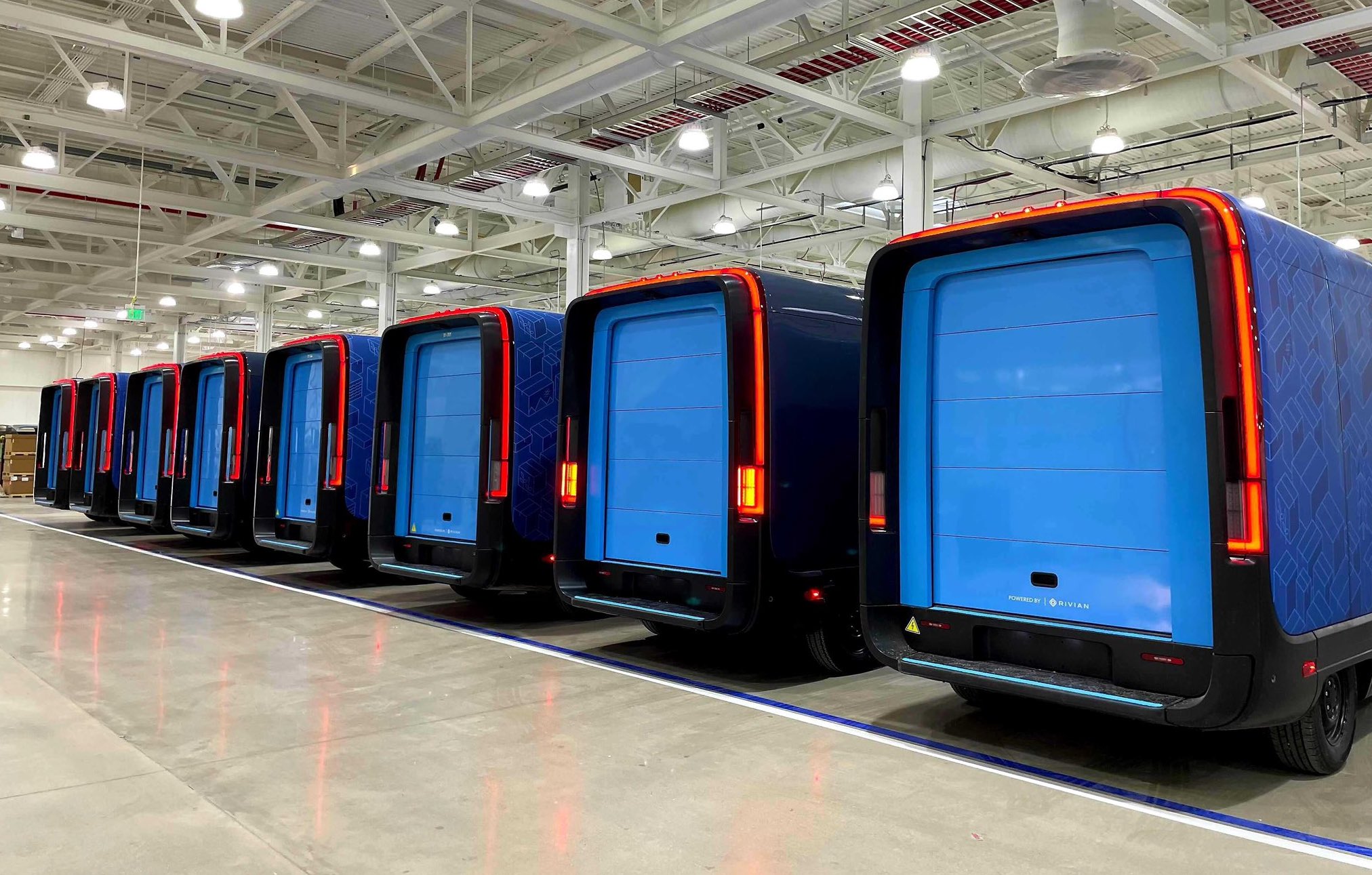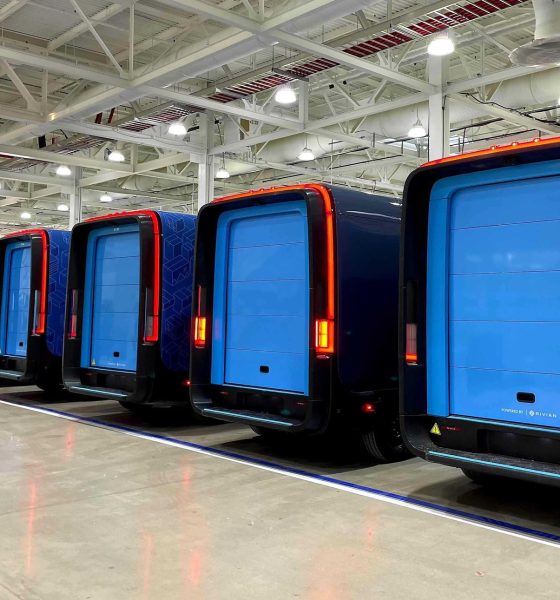

News
Rivian is prioritizing its Amazon delivery vans over R1T production: report
The production and impending deliveries of the Rivian R1T may be catching most of the electric vehicle community’s attention these days, but it appears that the truck maker may actually have a different priority in the near term. As per a recent report, Rivian is prioritizing the production of Amazon’s electric delivery van rather than the R1T pickup and the R1S SUV.
A Bloomberg report noted that Rivian CEO RJ Scaringe has decided to focus Rivian’s production capabilities on its Amazon delivery van project, citing people familiar with the matter. The publication’s sources claimed that the CEO is looking to build about 300 Electric Delivery Vans (“EDV”) by the end of this year, with the first 10,000 units due by the end of 2022. The entire 100,000 order is expected by the end of the decade. In comparison, R1T production is anticipated to run “at a trickle,” at least in the near term.
Prioritizing Amazon delivery van production seems to be a strategic decision for Rivian. After all, having Amazon as a customer is a notable advantage in the electric vehicle sector. Without its Amazon delivery vans, sources reportedly familiar with Rivian’s finances have told Bloomberg that it would be extremely challenging to hit the company’s target valuation of $80 billion when it goes for its initial public offering.
Rivian’s recent S-1 filing with the US Securities and Exchange Commission all but highlighted the close relationship between the electric vehicle company and the e-commerce giant. As per the filing, Amazon will have exclusive rights to Rivian’s Electric Delivery Vans for four years following the delivery of the first van. Amazon gets the right of first refusal to purchase the vans for two years after that point.
“Under the EDV Agreement, we and Logistics have agreed to collaborate to design, develop, manufacture, and supply EDVs and/or certain component parts and related services for use in Amazon’s last mile delivery operations. We also have agreed under the EDV Agreement that until the fourth anniversary of when Logistics first receives EDVs (the “Initial Delivery Date”), whether or not Logistics purchases any EDVs from us, we will exclusively provide last mile delivery vehicles to Amazon, and from the fourth anniversary to the sixth anniversary of the Initial Delivery Date, Amazon will have a right of first refusal to purchase last mile delivery vehicles that we produce,” the S-1 filing noted.
Rivian’s focus on the Amazon delivery van does not come without risks for the electric truck maker. In a statement to the publication, Ross Gale, a New Jersey-based car collector and business owner, noted that the Launch Green Rivian R1T he ordered last November is an exciting vehicle. However, the communication from the company so far has been quite lacking. “I 100% believe in the product, having never seen one, having never touched one. But I am annoyed with the failure to meet promises. I mean, just be honest. Tell us what you’re doing,” Gale said.
So far, Rivian has reportedly received refundable deposits for 48,390 R1T and R1S vehicles. This is a relatively conservative number, at least when compared to the Ford F-150 Lightning, which has received over 150,000 non-binding reservations to date. Unofficial trackers for Tesla Cybertruck orders currently estimate over a million pre-orders for the upcoming vehicle. However, the Rivian R1T and R1S are both premium trucks, which means that they are targeting a different demographic than the F-150 Lightning or the Cybertruck. RJ Scaringe is looking to create the Patagonia of trucks with Rivian, and for such a goal, 48,390 R1T and R1S reservations is not bad to start at all.
The Teslarati team would appreciate hearing from you. If you have any tips, reach out to me at maria@teslarati.com or via Twitter @Writer_01001101.

Elon Musk
Elon Musk’s X will start using a Tesla-like software update strategy
The initiative seems designed to accelerate updates to the social media platform, while maintaining maximum transparency.

Elon Musk’s social media platform X will adopt a Tesla-esque approach to software updates for its algorithm.
The initiative seems designed to accelerate updates to the social media platform, while maintaining maximum transparency.
X’s updates to its updates
As per Musk in a post on X, the social media company will be making a new algorithm to determine what organic and advertising posts are recommended to users. These updates would then be repeated every four weeks.
“We will make the new 𝕏 algorithm, including all code used to determine what organic and advertising posts are recommended to users, open source in 7 days. This will be repeated every 4 weeks, with comprehensive developer notes, to help you understand what changed,” Musk wrote in his post.
The initiative somewhat mirrors Tesla’s over-the-air update model, where vehicle software is regularly refined and pushed to users with detailed release notes. This should allow users to better understand the details of X’s every update and foster a healthy feedback loop for the social media platform.
xAI and X
X, formerly Twitter, has been acquired by Elon Musk’s artificial intelligence startup, xAI last year. Since then, xAI has seen a rapid rise in valuation. Following the company’s the company’s upsized $20 billion Series E funding round, estimates now suggest that xAI is worth tens about $230 to $235 billion. That’s several times larger than Tesla when Elon Musk received his controversial 2018 CEO Performance Award.
As per xAI, the Series E funding round attracted a diverse group of investors, including Valor Equity Partners, Stepstone Group, Fidelity Management & Research Company, Qatar Investment Authority, MGX, and Baron Capital Group, among others. Strategic partners NVIDIA and Cisco Investments also continued support for building the world’s largest GPU clusters.
News
Tesla FSD Supervised wins MotorTrend’s Best Driver Assistance Award
The decision marks a notable reversal for the publication from prior years, with judges citing major real-world improvements that pushed Tesla’s latest FSD software ahead of every competing ADAS system.

Tesla’s Full Self-Driving (Supervised) system has been named the best driver-assistance technology on the market, earning top honors at the 2026 MotorTrend Best Tech Awards.
The decision marks a notable reversal for the publication from prior years, with judges citing major real-world improvements that pushed Tesla’s latest FSD software ahead of every competing ADAS system. And it wasn’t even close.
MotorTrend reverses course
MotorTrend awarded Tesla FSD (Supervised) its 2026 Best Tech Driver Assistance title after extensive testing of the latest v14 software. The publication acknowledged that it had previously criticized earlier versions of FSD for erratic behavior and near-miss incidents, ultimately favoring rivals such as GM’s Super Cruise in earlier evaluations.
According to MotorTrend, the newest iteration of FSD resolved many of those shortcomings. Testers said v14 showed far smoother behavior in complex urban scenarios, including unprotected left turns, traffic circles, emergency vehicles, and dense city streets. While the system still requires constant driver supervision, judges concluded that no other advanced driver-assistance system currently matches its breadth of capability.
Unlike rival systems that rely on combinations of cameras, radar, lidar, and mapped highways, Tesla’s FSD operates using a camera-only approach and is capable of driving on city streets, rural roads, and freeways. MotorTrend stated that pure utility, the ability to handle nearly all road types, ultimately separated FSD from competitors like Ford BlueCruise, GM Super Cruise, and BMW’s Highway Assistant.
High cost and high capability
MotorTrend also addressed FSD’s pricing, which remains significantly higher than rival systems. Tesla currently charges $8,000 for a one-time purchase or $99 per month for a subscription, compared with far lower upfront and subscription costs from other automakers. The publication noted that the premium is justified given FSD’s unmatched scope and continuous software evolution.
Safety remained a central focus of the evaluation. While testers reported collision-free operation over thousands of miles, they noted ongoing concerns around FSD’s configurable driving modes, including options that allow aggressive driving and speeds beyond posted limits. MotorTrend emphasized that, like all Level 2 systems, FSD still depends on a fully attentive human driver at all times.
Despite those caveats, the publication concluded that Tesla’s rapid software progress fundamentally reshaped the competitive landscape. For drivers seeking the most capable hands-on driver-assistance system available today, MotorTrend concluded Tesla FSD (Supervised) now stands alone at the top.
News
Elon Musk’s Grokipedia surges to 5.6M articles, almost 79% of English Wikipedia
The explosive growth marks a major milestone for the AI-powered online encyclopedia, which was launched by Elon Musk’s xAI just months ago.

Elon Musk’s Grokipedia has grown to an impressive 5,615,201 articles as of today, closing in on 79% of the English Wikipedia’s current total of 7,119,376 articles.
The explosive growth marks a major milestone for the AI-powered online encyclopedia, which was launched by Elon Musk’s xAI just months ago. Needless to say, it would only be a matter of time before Grokipedia exceeds English Wikipedia in sheer volume.
Grokipedia’s rapid growth
xAI’s vision for Grokipedia emphasizes neutrality, while Grok’s reasoning capabilities allow for fast drafting and fact-checking. When Elon Musk announced the initiative in late September 2025, he noted that Grokipedia would be an improvement to Wikipedia because it would be designed to avoid bias.
At the time, Musk noted that Grokipedia “is a necessary step towards the xAI goal of understanding the Universe.”
Grokipedia was launched in late October, and while xAI was careful to list it only as Version 0.1 at the time, the online encyclopedia immediately earned praise. Wikipedia co-founder Larry Sanger highlighted the project’s innovative approach, noting how it leverages AI to fill knowledge gaps and enable rapid updates. Netizens also observed how Grokipedia tends to present articles in a more objective manner compared to Wikipedia, which is edited by humans.
Elon Musk’s ambitious plans
With 5,615,201 total articles, Grokipedia has now grown to almost 79% of English Wikipedia’s article base. This is incredibly quick, though Grokipedia remains text-only for now. xAI, for its part, has now updated the online encyclopedia’s iteration to v0.2.
Elon Musk has shared bold ideas for Grokipedia, including sending a record of the entire knowledge base to space as part of xAI’s mission to preserve and expand human understanding. At some point, Musk stated that Grokipedia will be renamed to Encyclopedia Galactica, and it will be sent to the cosmos.
“When Grokipedia is good enough (long way to go), we will change the name to Encyclopedia Galactica. It will be an open source distillation of all knowledge, including audio, images and video. Join xAI to help build the sci-fi version of the Library of Alexandria!” Musk wrote, adding in a later post that “Copies will be etched in stone and sent to the Moon, Mars and beyond. This time, it will not be lost.”








